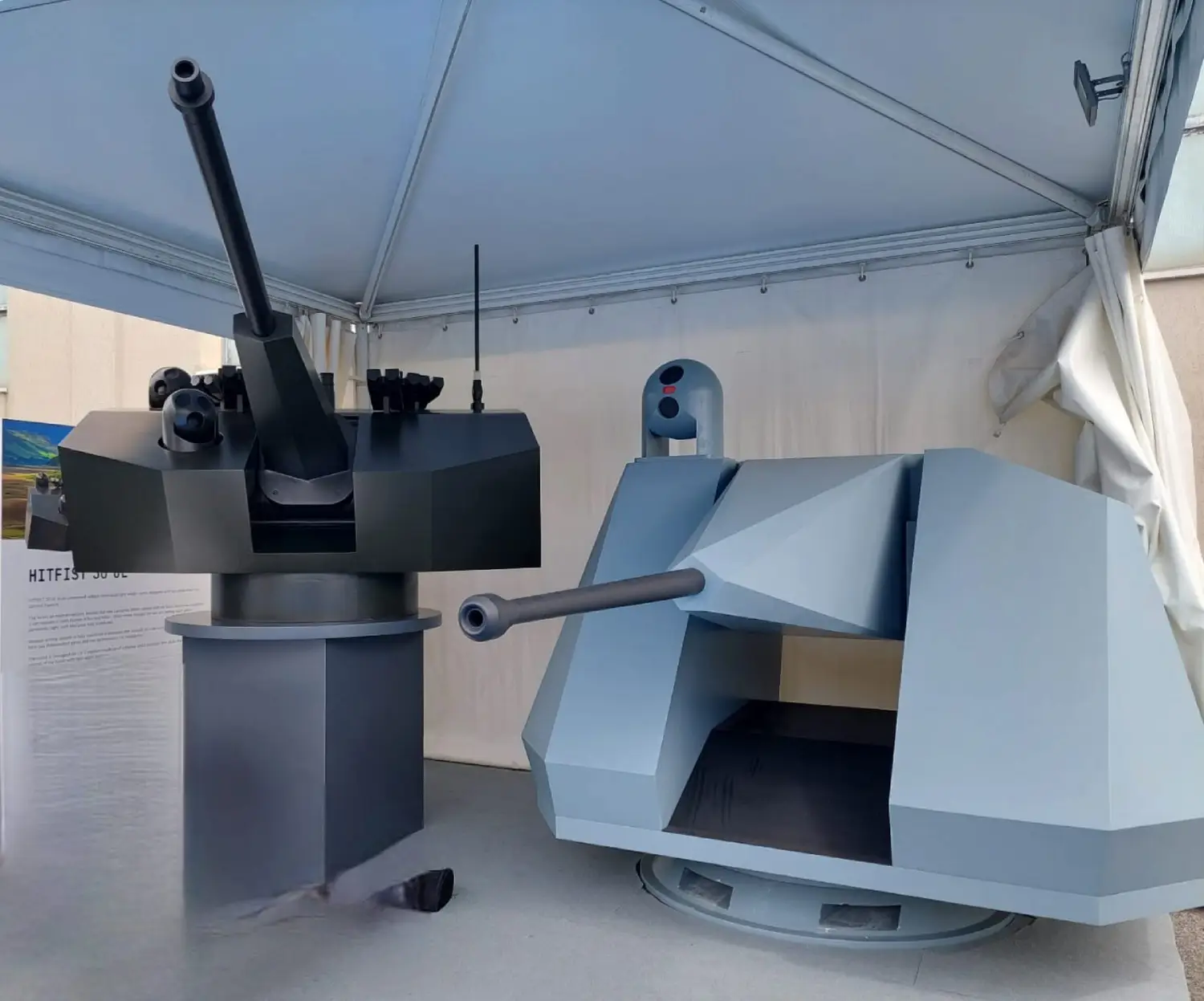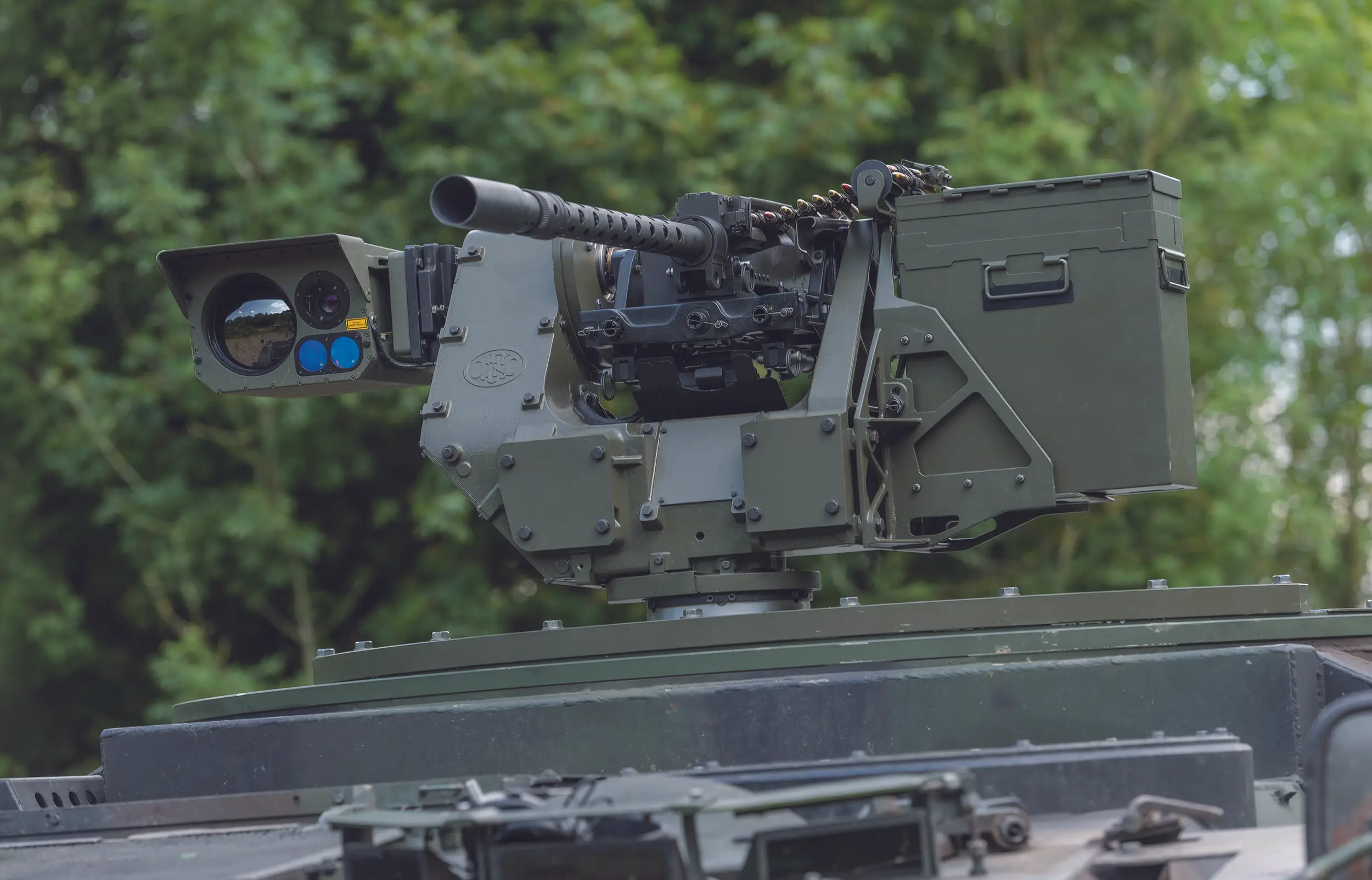
REPORT HOME > Expanded options
september 2023 | technology report | armoured vehicles
As remote weapon stations become more compact and flexible, developers are finding new uses for them on lighter and uncrewed vehicles, as well as adding extra sensors and effectors to the traditional gun and sight.
Above: RWS such as the EOS R150 will need to engage drones as well as ground-based threats in future. (Photo: EOS Defence Systems)
Remote weapon stations (RWS) are a growing focus for militaries around the world. There is an increasing emphasis on adapting these systems to address evolving threats and new platform classes, notably uncrewed vehicles.
There have been significant technological advances in RWS in recent years, said Matt Jones, executive VP of EOS Defence Systems, manufacturer of the R150, a 12.7mm RWS aimed at platforms where weight is constrained.
For example, he pointed to the introduction of the lightweight M230LF, a 30mm chain gun that enables high-calibre precision engagements, expanding the target capabilities of RWS.
‘Developments in ammunition choices and fusing technology have further contributed to defeating unmanned aerial systems, rendering RWS more versatile and effective,’ he added. ‘These enhancements collectively provide a more adaptable and cost-effective approach to modern warfare.’
The evolving strategic context necessitates further expansion in RWS targeting capabilities, Jones added, noting a shift from ground-based threats to include drones.
‘Precision in tracking and stabilisation is imperative for effective drone engagement. Failure to achieve these technical standards compromises the cost-effectiveness of the weapon station, especially when compared against systems specifically engineered for drone countermeasures,’ he added.
A further focus is on the integration of specialist features to add versatility and efficiency. One recent development is the addition of commander’s sights on turrets, providing both traditional sighting methods and hunter-killer capabilities for more rapid target acquisition, Jones said.
‘Additionally, the commander’s dedicated weapon system enables extended standard engagement ranges and offers a versatile solution for counter-drone operations. This approach makes it possible for non-specialised forces to counter drones at shorter ranges without the need for expensive, dedicated systems, using relatively simple means such as machine guns.’
Customer demand has evolved, he said, particularly in the context of uncrewed ground vehicles (UGVs) and autonomous systems. EOS has a particular focus here, he said, with the company’s systems used on robotic platforms in several countries and the development of strategic collaborations with prominent UGV manufacturers.
Weight factor
A Leonardo spokesperson said that weight is another key focus in RWS for armoured vehicles, due to the interest in using the systems on lighter tactical platforms. This is also a factor for installation on amphibious vehicles, they noted. Lightness and compactness were therefore key considerations in development of the company's HITFIST Uncrewed Light (UL) turret.
‘The benefits of an RWS system are lightness and optimisation of the vehicle internal space. However, the disadvantage is lower situation awareness of the crew compared to manned solutions,’ the spokesperson added.
‘Customers are increasingly looking to reduce this gap in RWS solutions, through the use of ever better sensors and optimised [human-machine interfaces].’
While a 30mm gun is the current reference standard – and Leonardo believes this will remain so for many years to come – the calibre increment trend continues, with some end users opting for 50mm weapons, the spokesperson added.
Above: A mock-up of Leonardo’s HITFIST UL (left). The company is seeing an increasing number of customers opt for 50mm weapons on such turrets. (Photo: Leonardo)
NATO states and their allies are also closely focused on interoperability, reliability and safety, said a spokesperson for FN Herstal, developer of the deFNder family of RWS.
There is a trend in high-end land systems to enable ‘collaborative combat’, the spokesperson added, reducing sensor-to-shooter time and supporting the decision-making of operators and commanders.
‘New fleets of armoured vehicles are designed for high connectivity and RWS are entering this… network,’ they confirmed. ‘Within the deFNder family we developed a “Platform Gateway” allowing deFNder to exchange data with the platform and by extension to the complete command and control system of land units.’
However, this gateway requires additional software development due to the uniqueness of each combat system it must work with. ‘We are monitoring closely the development of interoperability standards in the domain of land systems, counter-UAS and unmanned platform control,’ the spokesperson added.
Above: NATO members are closely focused on interoperability, reliability and safety, which is influencing RWS development according to FN Herstal, manufacturer of the deFNder Medium. (Photo: FN Herstal)
Hornet Defense meanwhile is developing three versions of its eponymous RWS for the French Army, namely the Hornet, Hornet Lite and Hornet S. The systems are designed for use in new vehicles developed under the Scorpion programme, the Griffon, Jaguar and Serval.
‘RWS are now a must-have and are required by most militaries who prioritise the protection of crews (against sniper but also IED threats),’ said a spokesperson for Hornet, a division of Arquus. ‘But also, they offer incomparable accuracy, much superior to regular manual machine guns, needing less ammo to be effective and allowing gunners to operate in much less stressful environments.’
The spokesperson said that battle management systems (BMS) are also a crucial part of the RWS environment: ‘Thanks to their optics and weapons, they can be at the centre of a complete collaborative combat solution, linking all functions and units on the battlefield. To get the most of your RWS you need to work on a potent and complete BMS.’
The turret as hub
Niv Cohen, head of the land manoeuvre division at Rafael, which manufactures the Samson RWS line, said there is an increasing demand for holistic solutions. This means that rather than focusing on a 30mm cannon in isolation, the turret functions as a hub comprising the weapon and the company’s Trophy active protection system (APS).
Additionally, Rafael has integrated its Spike LR2 missiles into the turret, as well as drones, which deliver intelligence and can be used in attack.
‘An all-in-one turret can provide better lethality, survivability and better intelligence and control,’ Cohen added. ‘It’s not just a weapon station, it’s a hub for the system.’
The war in Ukraine and other recent conflicts have highlighted how RWS enhance military capabilities and increase the safety of personnel, said Jones. Additionally, the conflict has highlighted the need for effective strategies to counter both ground and air targets.
‘RWS have emerged as an effective solution, offering a flexible hard-kill option that can be either mounted for on-the-move lethality or on fixed infrastructure, depending on the situation.’
Above: The Rafael Samson RWS is seen here installed on a Namer APC. (Photo: Rafael)
The spokesperson for FN Herstal said Ukraine has underscored the continued relevance of infantry fighting. ‘It also demonstrates that urban warfare can be avoided only by wiping out cities with heavy artillery,’ they said. This is not feasible for NATO nations, so tools such as RWS will remain crucial for urban warfare, the spokesperson added.
‘A second trend is the large-scale use of small drones, threatening all echelons of combat from the front line to rear units,’ they continued. ‘A consequence is that any unit is required to ensure its own force protection against that aerial threat at any time.’
It is impossible to have coverage from dedicated air defence units everywhere, the spokesperson said, so FN Herstal envisions RWS being used as pragmatic force protection systems against drones.
They would need to be ‘enhanced with ad-hoc sensors and effector management systems but this can be done at a fraction of the cost of dedicated weapon systems like missiles or SHORAD'.
The technological roadmap for deFNder includes several studies and prototypes focused on better and easier target acquisition: ‘We are also teaming through several European-funded projects on a joint control system that will be able, from one HMI, to control both a UxV and the RWS on board, allowing wider deployment in infantry units.’
Intelligent RWS
Looking to the future, Jones said EOS is working on integrating AI into its RWS, which he said would revolutionise target recognition and detection. ‘Utilising advanced algorithms and machine learning, our RWS will be able to identify and engage targets with enhanced speed and accuracy, reflecting a significant step forward in operational effectiveness and efficiency.’
Additionally, he pointed to the incorporation of higher-calibre weapons into the RWS, which would enable the upgrading of legacy vehicles. This would allow the reuse of existing platforms, ‘transforming them into unmanned assets but also offering a value-for-money solution for augmenting combat power’.
The Leonardo spokesperson predicted that RWS will become lighter and more compact in coming years, allowing more weight to be available for crew protection.
‘Particular attention will be given to defence against drone threats, where airburst ammunition is now mandatory, effective against all types of asymmetric threats.’
From counter-UAS functions to networked sensors, future generations of RWS will clearly be more than simple uncrewed gun turrets.



